
Combatant
11levofloxacin, ciprofloxacin,
azithromycin, rifampin
11This creature rose to notoriety after the “legionnaires Incident” in 1977, in which a group of veteran warriors were brutally attacked and left to die from fever, chills, diarhea and coughing.
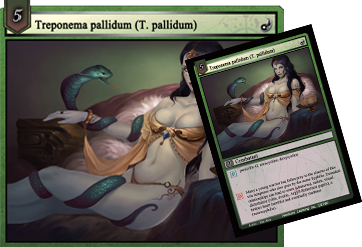
Combatant
penicillin G, Tetracycline,
doxycycline
Many a young warrior has fallen prey to the charms of this vile temptress who also goes by the name Syphilis. Extended relationships can lead to sores (chancres), rashes, visual disturbance (iritis, uveitis, ARGYLL ROBERTSON (IT’S HIS FIRST AND LAST NAME) pupils), a broken heart (aortitis) and eventually madness (neurosyphilis).
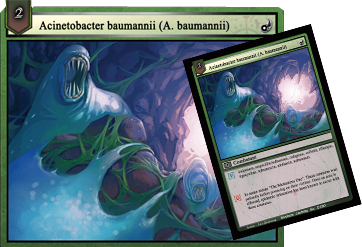
Combatant
imipenem, ampicillin/sulbactam, cefepime, colistin, rifampin, tigecycline, tobramycin, amikacin, aztreonam.
Its name means "The Motionless One". These creatures wait patientily before pouncing on their victims. Once an area is affected, epidemic infestation has been known to occur with these creatures.
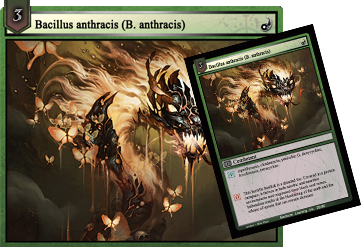
Combatant
ciprofloxacin, clindamycin, penicillin G, doxycycline, levofloxacin, tetracycline
This horrific basilisk is a dreaded foe. Covered in a protein carapace, it thrives in both aerobic and anaerobic environments and orginated from black coal mines. Infestation results in the blackening of the earth and the release of spores that can remain dormant.

Combatant
VANCOMYCIN, clindamycin, gentamicin, tobramycin, chloramphenicol, erythromycin
Like all members of the genus Bacillus, this creature is rod-shaped, but with a waxy skin that protects it from attacks Cereus is able to survive in both aerobic climes, preferring rice paddy fields as a natural habitat. This creature secretes a toxin that can cause profound vomiting and diarrhea.
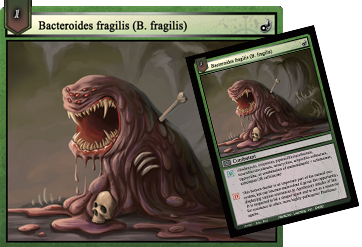
Combatant
clindamycin, imipenem, piperacillin/tazobactam, ticarcillin/clavulanate, tetracycline, AMPICILLIN/SULBACTAM, tigecycline, or combination of METRONIDAZOLE + cefotaxime, aztreonam OR ceftriaxone
This bottom-feeder is an important part of the natural ecosystem, but can become malevolent if given the opportunity, displaying various resistances to Apothecary attacks of late. It is suspected to be a sleeper agent and to act as a reservoir for resistance in other, more highly-pathogenic Pestilence agents.
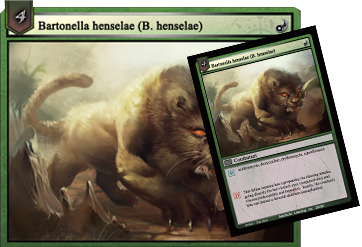
Combatant
azithromycin, doxycycline,
erythromycin, ciprofloxacin
This feline creature has a propensity for clawing attacks, going directly for her victim's eyes (conjunctivitis) and viscera (endocarditis and hepatitis). Rarely, the creature's bite can induce a feverish delirium (encephalitis).

Combatant
doxycycline, ceftriaxone,
penicillin G, tetracycline
This agent, which lives in ticks, inflicts Lyme Disease, which causes fever, headaches, fatigue, depression, and skin rash.
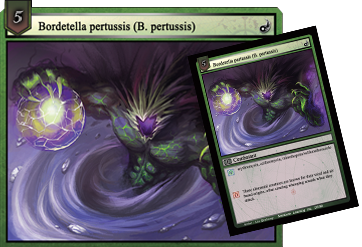
Combatant
erythromycin, azithromycin,
trimethoprim/sulfamethoxazole
These elemental creatures are known for their WIND- AND AIR-BASED orgins, often creating whooping sounds when they attack.
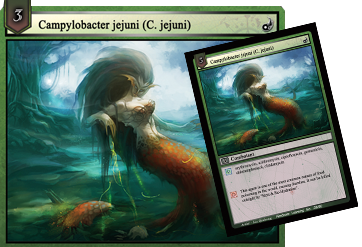
Combatant
erythromycin, azithromycin, ciprofloxacin, gentamicin, chloramphenicol, clindamycin
This agent is one of the most common causes of food poisoning in the world, causing diarrhea. It can be killed outright by "Rest & Re-Hydration".
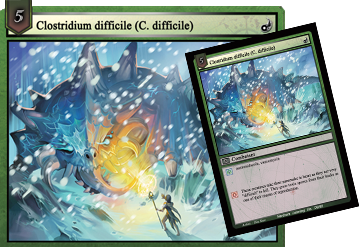
Combatant
metronidazole,
vancomycin
These creatures take their namesake to heart as they are very "difficult" to kill. They grow toxic spores from their backs as one of their means of reproduction.
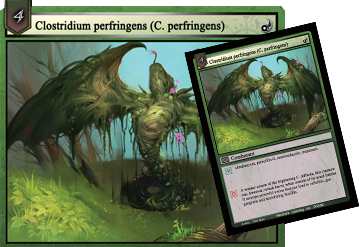
Combatant
clindamycin, penicillin G,
metronidazole, imipenem.
A weaker cousin of the frightening C. difficile, this creature can, however, wreak havoc when outside of its usual habitat. It secretes powerful toxins that can lead to cellulitis, gas gangrene and necrotizing fasciitis.
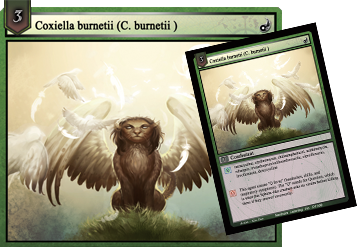
Combatant
tetracycline, erythromycin, chloramphenicol, azithromycin, rifampin, trimethoprim/sulfamethoxazole, ciprofloxacin, levofloxacin, doxycycline
This agent causes Q fever (headaches, chills, and respiratory symptoms). The "Q" stands for Question, which is what this Sphinx-like creature asks its victims before killing them if they answer incorrectly.
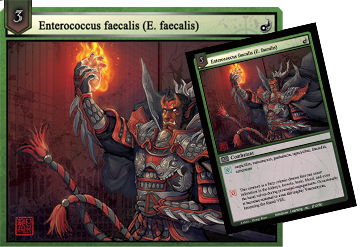
Combatant
ampicillin, vancomycin, gentamicin, tigecycline, linezolid, aztreonam
This creature is a fiery colonic demon that can cause infestation in the kidneys, bowels, brain, blood, and even the heart valves during protracted engagements. Occasionally it becomes resistant to even the mighty Vancomycin, becoming the feared VANCOMYCIN-RESISTANT ENTEROCOCCUS.
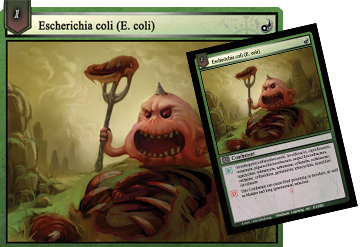
Combatant
trimethoprim/sulfamethoxazole, levofloxacin, ciprofloxacin, imipenem, piperacillin/tazobactam, ampicillin/sulbactam, tigecycline, tobramycin, aztreonam, cefazolin, ceftriaxone, cefepime, ceftazidime, gentamicin, tetracycline, ticarcillin/clavulanate
This Combatant can cause food poisoning in travelers, as well as bladder and lung (pneumonia) infection.
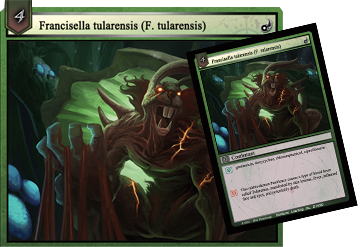
Combatant
gentamicin, doxycycline,
chloramphenicol, ciprofloxacin
This rabbit-demon Pestilence causes a type of blood fever called Tularemia, manifested by skin lesions, fever, inflamed face and eyes, and potentially death.
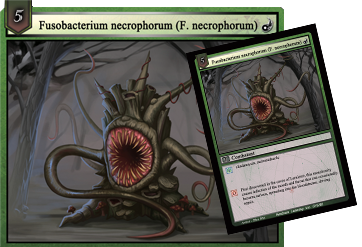
Combatant
clindamycin,
metronidazole
First discovered in the caves of Lemierre, this monstrosity causes infection of the mouth and throat that can occasionally become serious, spreading into the bloodstream, driving sepsis.
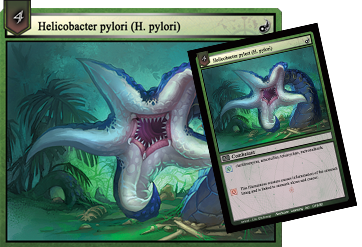
Combatant
clarithromycin, amoxicillin,
tetracycline, metronidazole
This filamentous creature causes inflammation of the stomach lining and is linked to stomach ulcers and cancer.
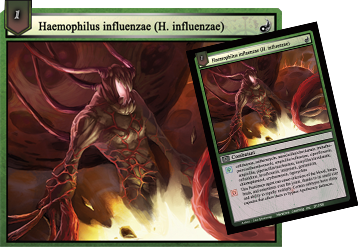
Combatant
ceftriaxone, azithromycin, amoxicillin/clavulanate, trimethoprim/sulfamethoxazole, ampicillin/sulbactam, ciprofloxacin, ampicillin, piperacillin/tazobactam, ticarcillin/clavulanate, ceftazidime, levofloxacin, imipenem, gentamicin, CHLORAMPHENICOL, erythromycin, tigecycline
This Pestilence agent can cause infection of the blood, lungs, brain, and sometimes even the joints, thanks to its small size and ability to rapidly multiply. Certain subtypes have slimy capsules that allow them to bypass Apothecary defences.

An Apothecary Healer or a Lord of Pestilence?
Choose your destiny and determine the course of events in the groundbreaking new game from Nerdcore Learning.
Developed by two physician/gamers, Francis Kong and Arun Mathews, Healing Blade plunges the player into a world of sorcery and creatures, where real-world knowledge of infectious diseases and therapeutics play a pivotal role in the winning strategy.
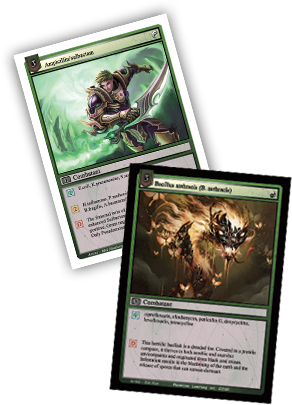

-The Apothecaries, Champions of the Healing Blade whose namesakes hearken from real world antibiotics.
-The Lords of Pestilence, Creatures of Disease and manifestations of actual bacterial agents.
As you and your opponent seek domination through corruption and conquest, you must vie not only with brute force, but also with planning, strategy, and most importantly, an astute understanding of microbiology and medical therapeutics.
Healing Blade gives you the unparalleled opportunity to enter a fantasy realm where the rules of combat deeply and accurately reflect the real world's battles against infectious disease. Reshape the Battlefield Zone to your advantage. At every turn you control the forces and special conditions that influence the outcome of each encounter. Each Champion has a unique set of gifts and abilities, and can be upgraded to powerful adversaries by way of real-world phenomena such as resistance and synergy. Summon forth living manifestations of diseases, or counter-attack with antibiotics in the form of powerful warriors.



